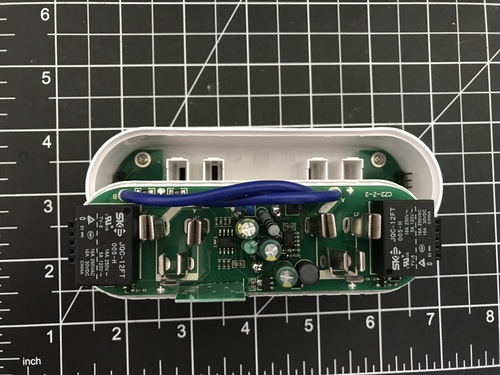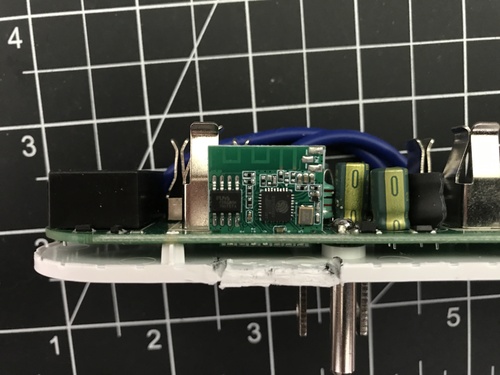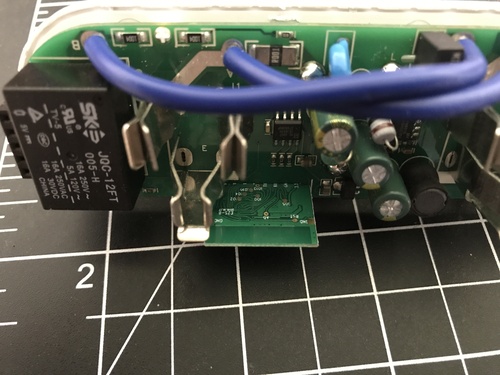NX-SP201
Dual outlet, dual relay socket with single channel power monitoring. Flashable via tuya-convert.
Multiple versions of this socket exist. The module the 'blue ESP' pinout came from was purchased from this Amazon link, but no guarantees that one purchased from that link is the same. Even more versions of the NX-SP201 outlet also exist, based on pinouts listed on other sites.
Flashing the wrong pinout can brick the device! Enabling GPIO9 bricked the 'blue ESP' version of the plug (though GPIO10 also gave a warning, but did not brick the device). Though it is recoverable with UART/GPIO0 flashing, desoldering the module to access the ESP module's pins can damage it. Only enable pins that give the 'pin might already be used by the flash interface' warning (GPIO6-11) once you're sure that's the correct pin.
GPIO Pinout
| Pin (Blue ESP) | Pin (Green ESP) | Function |
|---|---|---|
| GPIO0 | GPIO9 | Blue LED |
| GPIO3 | GPIO2 | HLW Select |
| GPIO4 (inverted) | GPIO14 | Button 1 |
| GPIO5 | GPIO4 | HLW CF |
| GPIO12 | GPIO10 | Relay 1 |
| GPI013 (inverted) | GPIO12 | Button 2 |
| GPI014 | GPIO5 | HLW CF1 |
| GPI015 | GPIO13 | Relay 2 |
Pictures





Basic Configuration
substitutions:
# Higher value gives lower watt readout
current_res: "0.002452"
# Lower value gives lower voltage readout
voltage_div: "814"
device_name: nx-sp201
friendly_name: Dilisens Outlet
relay1_name: Outlet 1
relay2_name: Outlet 2
# Basic Config
esphome:
name: ${device_name}
esp8266:
board: esp01_1m
# Enter you WIFI credentials
wifi:
ssid: !secret wifi_ssid
password: !secret wifi_password
# Enable Logging.
logger:
# Enable Home Assistant API.
api:
# Enable over-the-air updates.
ota:
# Enable WEB server for status and updates.
web_server:
port: 80
captive_portal:
binary_sensor:
- platform: gpio
pin:
number: GPIO14
inverted: False
internal: false # set to true to hide from hub
name: "${friendly_name} Button 1"
on_press:
- switch.toggle: relay1
- platform: gpio
pin:
number: GPIO12
inverted: False
internal: false # set to true to hide from hub
name: "${friendly_name} Button 2"
on_press:
- switch.toggle: relay2
# Status LED for blue light
# Enabling GPIO9 can brick certain versions of this plug!
#status_led:
# pin:
# number: GPIO09
# inverted: true
switch:
# Main relays
- platform: gpio
name: ${relay1_name}
id: relay1
pin: GPIO10
- platform: gpio
name: ${relay2_name}
id: relay2
pin: GPIO13
sensor:
# Energy Monitoring
- platform: hlw8012
sel_pin:
number: GPIO02
inverted: True
cf_pin: GPIO04
cf1_pin: GPIO05
#current_resistor: ${current_res}
voltage_divider: ${voltage_div}
change_mode_every: 3
update_interval: 3s
current:
name: "${device_name}_amperage"
unit_of_measurement: A
accuracy_decimals: 3
filters:
- calibrate_linear:
- 0.000 -> 0.0
- 5.069 -> 6.69
# Make everything below 0.01A appear as just 0A.
# Furthermore it corrects 0.013A for the power usage of the plug.
- lambda: if (x < (0.01 - 0.013)) return 0; else return (x - 0.013);
voltage:
name: "${device_name}_voltage"
unit_of_measurement: V
accuracy_decimals: 1
power:
name: "${device_name}_wattage"
unit_of_measurement: W
id: "${device_name}_wattage"
accuracy_decimals: 0
Split Configuration
If you have multiple of these sockets (some come in packs), you may want to keep the shared code in one file and only put device specific information in files for each relay.
nx-sp201-common.yaml:
# Basic Config
esphome:
name: ${device_name}
esp8266:
board: esp01_1m
# Enter you WIFI credentials
wifi:
ssid: !secret wifi_ssid
password: !secret wifi_password
# Enable Logging.
logger:
# Enable Home Assistant API.
api:
# Enable over-the-air updates.
ota:
# Enable WEB server for status and updates.
web_server:
port: 80
captive_portal:
binary_sensor:
- platform: gpio
pin:
number: GPIO14
inverted: False
internal: false # set to true to hide from hub
name: "${friendly_name} Button 1"
on_press:
- switch.toggle: relay1
- platform: gpio
pin:
number: GPIO12
inverted: False
internal: false # set to true to hide from hub
name: "${friendly_name} Button 2"
on_press:
- switch.toggle: relay2
# Status LED for blue light
# Enabling GPIO9 can brick certain versions of this plug!
#status_led:
# pin:
# number: GPIO09
# inverted: true
switch:
# Main relays
- platform: gpio
name: ${relay1_name}
id: relay1
pin: GPIO10
- platform: gpio
name: ${relay2_name}
id: relay2
pin: GPIO13
sensor:
# Energy Monitoring
- platform: hlw8012
sel_pin:
number: GPIO02
inverted: True
cf_pin: GPIO04
cf1_pin: GPIO05
#current_resistor: ${current_res}
voltage_divider: ${voltage_div}
change_mode_every: 3
update_interval: 3s
current:
name: "${device_name}_amperage"
unit_of_measurement: A
accuracy_decimals: 3
filters:
- calibrate_linear:
- 0.000 -> 0.0
- 5.069 -> 6.69
# Make everything below 0.01A appear as just 0A.
# Furthermore it corrects 0.013A for the power usage of the plug.
- lambda: if (x < (0.01 - 0.013)) return 0; else return (x - 0.013);
voltage:
name: "${device_name}_voltage"
unit_of_measurement: V
accuracy_decimals: 1
power:
name: "${device_name}_wattage"
unit_of_measurement: W
id: "${device_name}_wattage"
accuracy_decimals: 0
And for each device's yaml:
substitutions:
# Higher value gives lower watt readout
current_res: "0.002452"
# Lower value gives lower voltage readout
voltage_div: "814"
device_name: nx-sp201
friendly_name: Dilisens Outlet
relay1_name: Outlet 1
relay2_name: Outlet 2
<<: !include nx-sp201-common.yaml